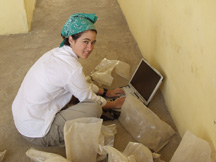
December 12, 2008
Archaeologists, like Sherlock Holmes, depend on tiniest of clues
 |
Sometimes it's the tiniest fragments — a broken tooth or sherd of pottery — that help archaeologists piece together an ancient story. In a Purdue lab, bioarchaeologist Michele Buzon is looking at the most miniscule traces of evidence — by studying chemical signatures on human remains — to answer 3,000-year-old questions about the origin and relations between the Egyptians and Nubians in the Nile Valley of Northern Sudan.
"As soon as you say the Nile Valley, people often think of King Tut and pharaohs," says Buzon, assistant professor of anthropology. "People have this idea from movies and TV that archaeologists are just treasure hunting. But archaeology is not about getting rich or the search for a precious artifact. It's learning about the human condition in the past to understand who we are today."
Buzon and her team have spent about 24 weeks during 2000, 2002 and 2005 excavating the site of Tombos in the Nile Valley region. Thanks to a National Geographic Society grant, she will return in 2010 to study a different time period.
Tombos is located north of the capital, Khartoum, where the research team begins each excavation season. After a 16-hour drive through the desert, Buzon and her colleagues reach the village of Tombos, where they rent a house from the family that watches the site when the archaeologists are not there. The team, which includes professors, graduate students, local workers and a representative from Sudan's antiquities department, works six days a week. While working in this Muslim country, the archaeologists respect local customs by keeping Friday as a day of rest and making sure the women dress modestly.
The site of Tombos was a colonial outpost for the Egyptians, who were ruling Nubians at the time of the Egyptian New Kingdom period, 1400-1070 B.C. During this era, the Egyptians were colonizing, and Buzon is interested in knowing how Egyptians administered Nubia. There are no books that document the government structure, and even burial sites may be misleading.
"The cemetery looks very Egyptian during this time period because Nubians are burying themselves like Egyptians," Buzon says. "They even adopted their religious practices, so it's hard to tell who they are just by looking at the burials."
The burials consist of an elite Egyptian-style pyramid with a funerary chapel and a middle-class cemetery.
After the 2005 excavation, Buzon returned with the human remains to conduct a chemical analysis. A College of Liberal Arts grant made it possible for Buzon to partner with Gabriel Bowen, assistant professor in the Department of Earth and Atmospheric Sciences, who is collaborating on the oxygen isotope analysis of human tooth enamel.
The ratio of isotopes will reveal whether water consumed by an individual is from local sources, which identifies where a person was living when the tooth enamel was forming. Differences in isotopes can indicate people are from different places.
"Unfortunately, Sudan does not have the facilities to house these specimens," Buzon says. "With permission from the Sudanese government, I've been able to organize these specimens in a collection that will be kept safe for additional study and will help us understand more about these cultures."